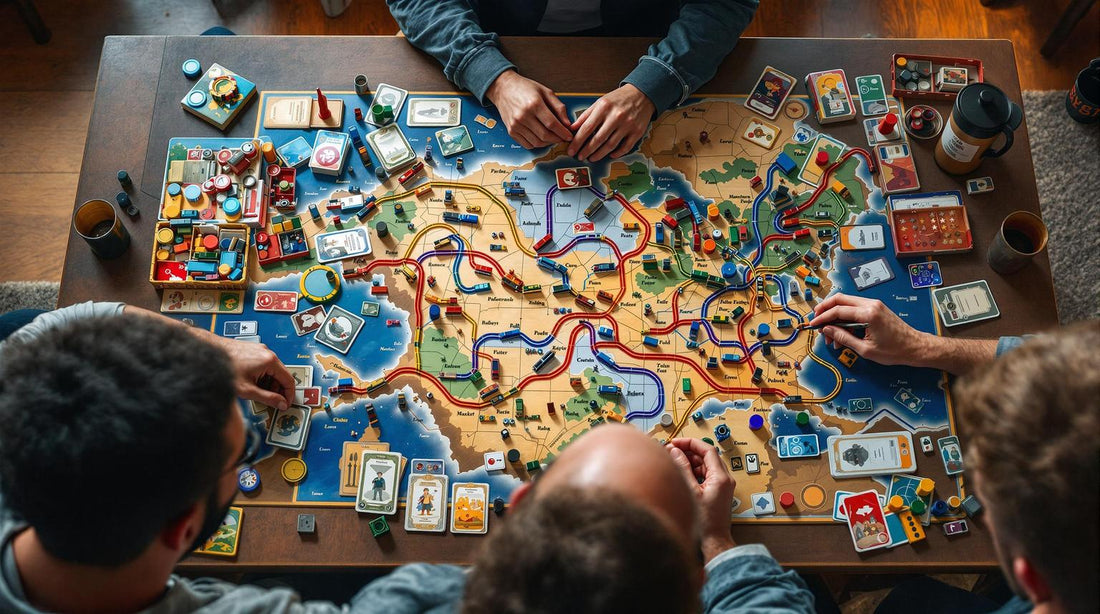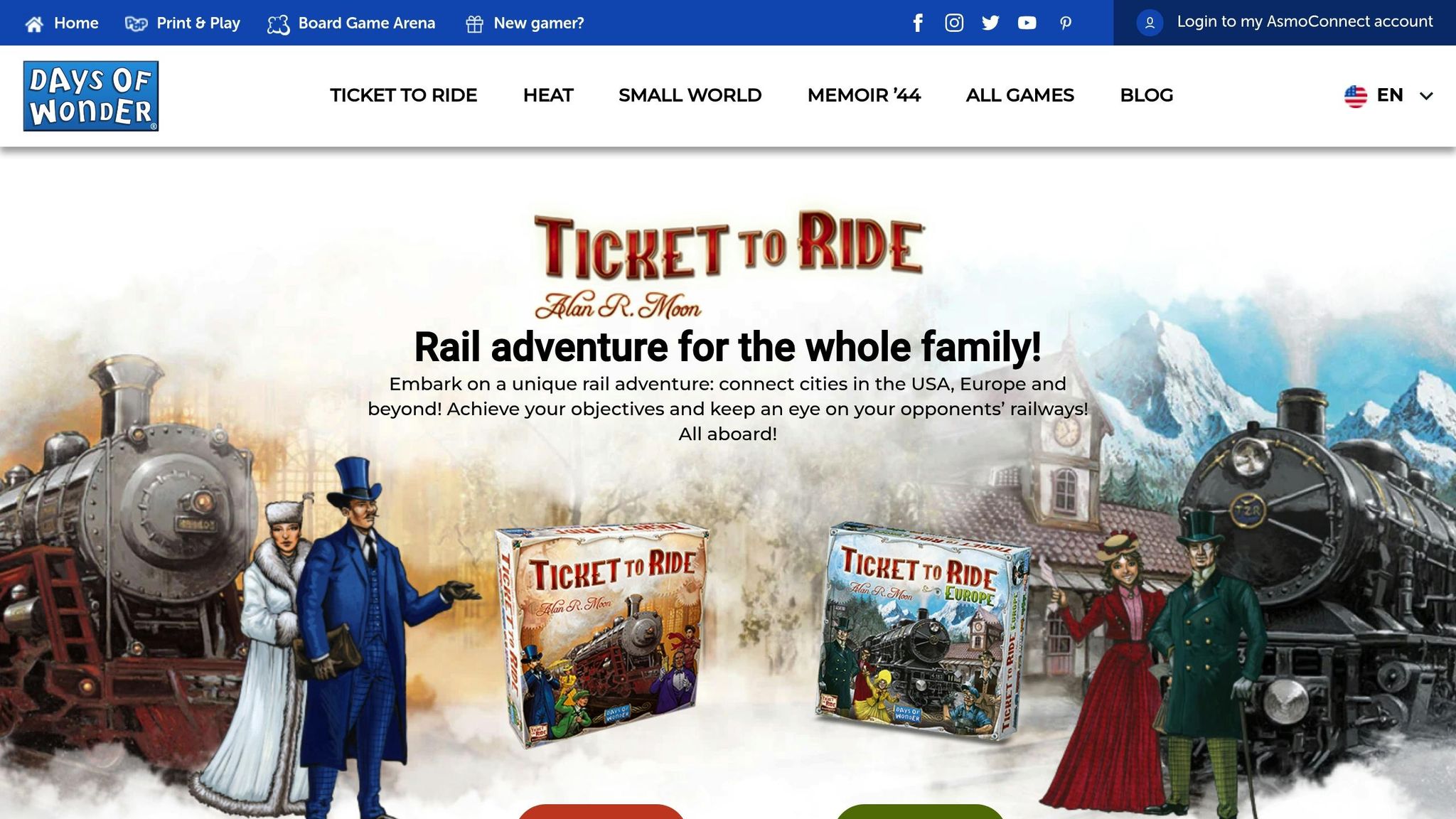Discover the Best Board Games for Every Player

10 Tips for Winning Ticket to Ride
Want to win at Ticket to Ride? Here’s a quick guide to mastering the game:
- Choose Starting Routes Wisely: Focus on high-point routes (like Seattle to New York or LA to Miami) and align smaller tickets with larger ones.
- Secure Critical Connections Early: Lock down chokepoints like Las Vegas or key grey routes (e.g., Houston to New Orleans).
- Pick Cards Strategically: Start with face-down cards, then shift to face-up cards for specific colors. Save wild cards for critical moments.
- Prioritize Long Routes: Longer routes (e.g., 6 cars = 15 points) are more efficient for scoring.
- Block Opponents Smartly: Block critical paths only when it benefits your strategy, especially in smaller games.
- Count Your Trains: Manage your pieces carefully to maximize points as the game nears its end.
- Aim for the Longest Route Bonus: Build a single, continuous train path for 10 extra points.
- Draw Extra Tickets Carefully: Only take new tickets when they align with your current routes and resources.
- Adapt When Plans Change: Stay flexible if opponents block your routes or cards don’t go your way.
- Practice and Learn: The more you play, the better you'll get at spotting opportunities and countering opponents' moves.
Pro Tip: Balance your strategy between completing tickets, blocking opponents, and building long routes for maximum points. Use these tactics to dominate the board and become a Ticket to Ride champion!
The Ultimate Ticket To Ride Strategy Guide

1. Choose Starting Routes
Your starting route decisions set the tone for your entire strategy, influencing your points and control over the board.
Go for High-Point Routes First
Long routes connecting major coastal cities are your best bet for racking up points. Examples include Seattle to New York (22 points), Los Angeles to New York (21 points), and Los Angeles to Miami (20 points). These routes not only bring in big points but also give you a strong presence across the board.
Prioritize Key Cities
Some cities are harder to connect due to limited tracks, like Las Vegas, which has only two single-track connections. Securing these cities early can stop opponents from cutting off your planned routes.
Plan Complementary Routes
Pick smaller tickets that align with your main route. For instance, if you’re building New York to Los Angeles, adding Pittsburgh to Denver works well since it fits along the same path. This overlap helps you save trains while completing multiple tickets.
Cities to Watch
Certain cities show up often in destination tickets and act as major hubs:
- New York
- Los Angeles
- Miami
- Vancouver
- Las Vegas
What to Consider When Choosing Routes
Keep these factors in mind:
- The number of players, which impacts route availability
- The risk of opponents blocking critical paths
- How well a route connects to multiple tickets
- Access to chokepoint cities like Las Vegas
2. Secure Must-Have Connections
Critical Connections Matter
Locking down essential route segments early can make all the difference in your strategy. Focus on short but important paths that could block your opponents from completing their plans.
Target These First
Pay close attention to grey routes - these can use any color and often become hotly contested. For instance, the Houston to New Orleans grey route is a key section, especially if you're aiming to complete the Los Angeles to Miami route. Securing these segments can give you control over fragile city connections and disrupt your opponents' plans.
Strategic City Access
When mapping out your routes, prioritize cities with limited connections. Single-track segments are particularly vulnerable to being blocked, so make sure to secure them early. Establishing control at both the start and end of your planned route can safeguard your strategy.
Timing Is Everything
Claim those one-train segments as soon as you have the necessary cards. Waiting too long can leave you exposed, allowing opponents to cut off your key pathways and derail your strategy.
Stay Flexible
Grab extra destination cards early to open up alternative routes. Having backup options can save your game if critical segments are taken by other players.
3. Pick Cards Smart
Choosing the right cards is key to turning your strategy into points.
Early Game Strategy
Start by drawing face-down cards. This not only gives you a variety of options but also keeps your strategy hidden from other players.
Face-Up vs. Face-Down
If you need a specific color, switch to drawing face-up cards. Keep an eye on the board to see what’s available. Remember, each color has 27 route segments.
Wild Card Strategy
There are 14 wild locomotive cards in the game that can replace any color. Hold onto these for critical routes later on. If three wild cards show up on the board, wait for them to refresh before drawing.
Focus on One Color
When you see a color you need, grab as many of those cards as you can. This is especially useful once you know which routes are essential for your plan (each color has 12 cards).
Timing is Everything
As the game advances, don’t hesitate to take face-up wild cards to complete your routes. Watch how many trains your opponents have left to time your moves effectively.
Have a Backup Plan
If you’re stuck waiting for a card, consider drawing new destination tickets. This can help you find alternative paths and keep your game moving.
4. Focus on Long Routes
After securing key cards and routes, shift your attention to building longer routes. These offer higher point rewards compared to multiple shorter ones.
Point Values by Route Length
| Train Cars | Points Earned |
|---|---|
| 1 car | 1 point |
| 2 cars | 2 points |
| 3 cars | 4 points |
| 4 cars | 7 points |
| 5 cars | 10 points |
| 6 cars | 15 points |
Maximizing Points Efficiently
A single 6-car route gives you 15 points, while six separate 1-car routes only add up to 6 points. Longer routes are a more efficient way to boost your score. Try to align your destination tickets with these longer connections for the best results.
Strategic Route Choices
When selecting destination tickets, look for options that allow you to link major cities using long routes. For example, the Los Angeles to New York route is worth 21 points, making it a valuable target.
Extra Points for Long Networks
Building a large, connected network can help you earn the "Longest Continuous Path" bonus. This 10-point bonus goes to the player with the longest unbroken chain of train cars and can make all the difference in a tight game.
Efficient Card Collection
Start gathering cards early, focusing on sets of the same color to claim long routes before your opponents. Securing key connections quickly can give you a strong advantage.
Balancing Risk and Reward
While prioritizing long routes can be risky, it's smart to have a backup plan. Mix in some medium-length routes to stay flexible and keep your scoring options open.
5. Block Key Routes
Blocking key routes can increase your chances of winning by not only advancing your plans but also slowing down your opponents.
Routes to Prioritize
Focus on cities with limited connections that act as bottlenecks. For example, taking control of the Houston to New Orleans route can force your opponents to find alternate paths, especially when that link is crucial for long-distance routes.
Timing Your Blocks
Blocking is most effective in games with 2 or 3 players since disrupting one player's strategy can have a bigger impact. However, don’t rush into blocking early. Board game expert Ashton Wu advises:
"Don't unnecessarily block your opponents early on, as doing so will leave you vulnerable and not offer many points. Instead, collect train cards patiently to build a larger pool of options. This will allow you to make a powerful late-game surge by claiming long routes."
This advice highlights the importance of timing. Knowing when to block can make all the difference.
Targeting Key Cities and Routes
Once you've got your timing down, focus on routes that are short, easy to claim, and vital for connecting major regions. For instance, the Nashville to Atlanta route is a strong candidate due to its strategic location and limited alternatives.
Observing Opponent Moves
Watch your opponents closely. Pay attention to their card collections and the routes they’re aiming for. This can give you clues about their plans and help you decide where to block.
Keeping Blocking Balanced
Blocking should complement your overall strategy. The best blocks are those that help you complete your own tickets or secure important routes. Blocking purely to disrupt others often doesn’t pay off.
Advanced Tactics
For a more advanced approach, consider creating a nonlinear route that disrupts multiple paths while still aligning with your own goals. This way, you can maximize the impact of your blocking efforts.
sbb-itb-1ed942f
6. Count Your Trains
Keep an eye on your train pieces - when any player has two or fewer left, the game ends. Managing your trains wisely can make all the difference.
Managing Your Trains Effectively
Running out of trains too soon can leave you unable to claim high-value routes. Always keep track of how many pieces you have left before committing to new routes.
Timing in the End Game
As your train supply gets low, timing becomes just as important as strategy. Use your remaining turns to finish critical routes, monitor opponents' train counts, and aim to score as many points as possible with each move.
Choosing Routes Wisely
Focus on routes that give you the most points for each train used. Keep a small buffer of extra trains to allow for flexibility in case plans change. Make sure you have enough trains to complete your most important routes with a little room to spare.
Making the Most of Your Final Turn
If you've already completed several routes, consider using your last turn to draw additional destination tickets for a chance at bonus points. Managing your train pieces carefully can help you lock in key routes and stay ahead of the competition.
7. Get the Longest Route Bonus
Earning the Longest Route Bonus adds 10 extra points to your score and is featured in many versions of Ticket to Ride, such as USA, Europe, Team Asia, France, Switzerland, and India.
How to Build the Longest Route
Focus on creating one uninterrupted path using your trains. Avoid networks with disconnected hubs or spokes, as only your single, continuous route will count toward the bonus.
Tips for Efficiency
- Connect overlapping segments: Aim for routes that overlap rather than scattering shorter ones across the board.
- Incorporate loops: Loops can extend your route, but remember, no train piece can be counted twice.
Key Strategies
Make sure your route allows smooth, uninterrupted travel without doubling back. Keep an eye on opponents who may try to block your path. In closely contested games, this bonus can give you the edge you need to win.
Pro Tips
- Focus on building routes that steadily expand your network.
- Prioritize longer routes instead of several short ones.
- Place trains strategically to allow for future growth.
Note: Some expansions replace the Longest Route Bonus with the Globetrotter bonus, which rewards players for completing the most tickets. Adjust your strategy accordingly to maintain a strong presence on the board.
8. Pick Extra Tickets Wisely
Drawing extra destination tickets can help increase your score if you complete them, but failing to do so will cost you points. It's all about timing and evaluating your network before deciding to take on more tickets.
Mid-Game Strategy
The middle of the game is often the best time to draw extra tickets, especially if you've finished most of your routes and still have at least 17 trains left. This gives you a solid foundation to assess and handle new tickets effectively.
Risk Assessment
Think carefully about the risks and rewards of each ticket. The rules make it clear:
"There's no such thing as a ticket that's 'started' vs 'not started.' When you take a ticket, you must complete that route, or lose points for not having completed it".
This means every ticket you draw is a commitment, so choose wisely.
Smart Selection Strategies
Adding extra tickets is like planning your routes or drawing cards - it’s about balancing risk and reward. Here are some tips:
- Check alignment with your current network: Make sure new tickets fit well with the routes you’ve already built.
- Count your remaining trains: Ensure you have enough resources to complete any new routes.
- Compare ticket value to penalties: Consider whether the points you could gain outweigh the risk of losing points.
Late-Game Considerations
By the end of the game, only draw extra tickets if the situation strongly favors it:
- If you're trailing in points and shorter routes can help you close the gap.
- If your existing network already connects the destinations on the new tickets.
In the late game, taking extra tickets is a calculated move - stick to it only when you're confident they can be completed quickly.
9. Change Plans When Needed
Being flexible in Ticket to Ride can make all the difference between winning and losing. Knowing when and how to adjust your strategy is key.
Reading the Game State
Pay close attention to your opponents. Are they targeting routes you need? Are they collecting cards that could interfere with your plans? Spotting these patterns helps you decide the right moment to change course.
When to Pivot
Sometimes, your original plan won't work out. Maybe an opponent blocks a critical route, or you're stuck waiting for specific cards. Here's how to adapt:
-
Blocked Critical Routes
If someone cuts off your planned path, consider these options:- Use shorter, connected routes through different cities.
- Find an alternative path around the blockage.
- Shift focus to completing other tickets while waiting for better opportunities.
-
Card Drawing Inefficiency
If you're spending too many turns trying to draw specific cards, it might be time to explore alternative routes.
Smart Strategies for Adjustments
Always have backup routes in mind. These options can save you when plans go awry. As the game progresses, staying flexible becomes even more important.
Late-Game Adjustments
When resources are running low and the game is nearing its end, make moves that maximize your remaining turns:
- Pick shorter destination tickets if longer routes seem too risky.
- Let go of routes that require too many specific cards.
- Focus on routes that offer quick, guaranteed points.
These tactical shifts help you collect points efficiently and avoid penalties from incomplete routes. Staying adaptable keeps you in the game and strengthens your overall strategy.
10. Keep Playing to Improve
The best way to sharpen your skills is simple: keep playing. Regular play helps you refine strategies and build confidence.
Mastering the Board and Cards
Frequent games improve your familiarity with routes and scoring, especially key connections like Los Angeles to New York. Over time, you'll naturally improve in areas such as:
- Spotting high-value routes quickly
- Timing card collection for maximum efficiency
- Understanding the distribution of the 110 train cards
Learning to Read Opponents
The more you play, the better you'll get at predicting your opponents' moves. You'll start noticing patterns in their strategies and learn how to adjust your approach to counter them effectively.
Key Areas to Focus On
Consistent practice helps you sharpen these essential skills:
- Route Efficiency: Learn to pick routes that complement each other, earn the most points per train, and avoid wasting moves.
- Timing Decisions: Know when to claim critical routes, draw destination tickets, or shift strategies mid-game.
- Strategic Awareness: Keep an eye on opponents without giving away your plans, anticipate blockades, and identify the best route combinations.
Every game is a chance to expand your strategic toolkit. With regular play, you'll turn theoretical strategies into practical expertise, adapting seamlessly to any game scenario.
Conclusion
Dominate the board in Ticket to Ride by combining careful planning, smart adjustments, and tactical decisions.
Strategic Planning and Information Management
"Your strategic plan should focus on the long-term goal... This will allow you to make a powerful late-game surge by claiming long routes".
Keep a close eye on face-up cards and track your opponents’ actions to guard your strategy. Balancing foresight with flexibility creates opportunities to outmaneuver your competition and maintain control.
Key Tactics for Success
Winning at Ticket to Ride hinges on a few essential tactics:
- Securing critical routes early in the game
- Collecting cards efficiently to match your goals
- Anticipating and countering your opponents’ strategies
- Adjusting quickly when plans don’t go as expected
Use these tactics to refine your gameplay and stay ahead. Once you’ve mastered these strategies, explore other Ticket to Ride editions from Brain Games to continue challenging yourself.






